- Home
- James Axler
Polestar Omega Page 7
Polestar Omega Read online
Page 7
Beyond yet another bulkhead, the hallway was ablaze with powerful lights. The corridor widened on the left to double its size to accommodate several rows of benches facing what turned out to be a long, floor-to-ceiling wall of armored glass.
The klieg lights were on the far side of the window. They were marched up to it and their noses were pressed against the glass. It was a viewing platform of sorts. Krysty took in a sheer cliff of pale blue ice and an intervening, yawning chasm whose bottom she could not see. She wasn’t sure at first what else she was looking at. The intricate scaffolding made her think it was something under construction. But why would they build it in the middle of a block of ice so far underground?
Protruding from the ice cliff was a dark, disk-shaped structure. Dozens of workers in orange coldsuits crawled over an outer surface that appeared partially skeletonized. Their size gave her a sense of the overall scale, which she found shocking. The disk was immense, maybe two hundred feet across from edge to edge, and canted at a slight angle. About a third of it looked to be still buried in the glacier. Lights blasting from inside it revealed the crisscross of complex support members and interior sheathing. Beneath the main structure she could see what appeared to be rocket engines in long, parallel pods. Was it an aircraft of some sort? It was difficult for her to imagine that such an enormous thing could fly. The workers who stood inside the lips of the engine housings looked like ants.
“Dark night! What’s that?” J.B. asked.
“The Holy Grail of Science,” Lima replied.
“That doesn’t explain anything,” Krysty said.
“Originally it was known as Project Arcturus,” Lima said. “We call it the Ark for short.”
“The Ark as in Noah and the flood?” J.B. asked. “Are you going to wait until the glacier melts and then sail it out of here? That shouldn’t take long—mebbe a million years.”
The whitecoat eyed him balefully. “Why am I wasting my time talking to you idiots? Do you even know what a spacecraft is?”
The female whitecoat’s eyes twinkled in delight. She was fawningly amused.
“Of course we know what it is,” Krysty said. “You can’t be building that thing a mile under the ice, so you’ve got to be taking it apart.”
Lima seemed pleased by her response. He pointed at the disk and said, “What you are looking at is a craft that has traveled between the stars. A ship designed and flown by alien beings. You should be honored and awed by this singular privilege.”
“Looks like junk to me,” Ricky said.
Lima didn’t react to the comment, other than smirking. “That ship crash-landed on the surface of Antarctica more than one hundred thousand years ago,” he said. “The date was derived from ice core samples. The ship became buried in snow, which compressed under its own weight, liquified and turned to ice. The ice became incorporated into the prehistoric glacier, and over time, inch by inch, the craft was subducted deeper and deeper, until it was a mile down. It is a testament to the craft’s structural engineering that despite the crushing pressures, it remained virtually intact, trapped like a bug in amber.”
“How was it found and when?” Krysty asked. “Was it predark?” She wasn’t really interested in the answers, only in delaying whatever Lima had in store for them, and perhaps finding a way to get free.
Jak gave her a wink that said he was thinking the same thing. She could see blood smeared on his pale hands from twisting in vain against the cuffs.
“You are correct,” Lima said. “The Ark was discovered in 1985, but it took twelve years and tens of billions of dollars to reach it. The initial find came during a U.S.-sponsored oil reserve survey. All resource extraction was banned by international treaty at the time, but not the mapping of subsurface geologic structures. Deep sonar soundings of the Ross Ice Sheet revealed the presence of a metallic object of great size and an unusual shape for a natural-occurring artifact. More soundings were taken to define its precise boundaries, then core samples were drilled from it.
“When the U.S. government realized what it might have stumbled onto, the area was sealed off to unauthorized personnel, essentially militarized and the construction of Polestar Omega began, top priority, with a bigger budget and shorter construction deadline than any of the other redoubts in the system. Although it was publicly identified as a research station dedicated to monitoring global warming, its true purpose was to secretly mine and catalog the information that was contained in the extraterrestrial craft. The Ark is a veritable cornucopia of advanced technology and theoretical science. A time machine that jumps aeons of trial and error.”
“You’re still investigating that wreck after a hundred years?” J.B. asked. “What’s taken you so long?”
“Not only was the technology far beyond human understanding,” Lima said condescendingly, “but to decipher it we had to come to grips with the alien intelligence that had created it, untangling extraterrestrial concepts of mathematics, physics, biology, chemistry and engineering, and an alien symbolic language and system of numerology radically different than anything ever encountered. It has been like trying to decode Egyptian hieroglyphics without a Rosetta stone.”
“Who is this woman Rosetta?” Ricky asked.
“You are an utter moron,” Lima said.
“Es tu madre,” Ricky replied.
Clearly the whitecoat didn’t understand the nature of the slur, or the reason why all four of his captives were suddenly smiling at him.
“The nuclear apocalypse sealed us off from the rest of the world,” Lima went on, “but of course we were very isolated to begin with. When resupply flights from the U.S. stopped in January of 2001, we had to become even more self-sufficient. Much of the advanced technology on display in this redoubt is the by-product of our alien research. That includes innovations in aviation science and biochemistry that allowed us to better adapt to a hostile environment.”
Krysty nodded at the workers scurrying in and out of the frozen hulk. “Those guys all seem to be in a great big hurry. If it’s going to take you another hundred years to finish the job, what’s the rush?”
“Our investigation is coming to a premature end,” Lima said. “The decision has been forced on us by the passage of time and the cumulative effect of natural processes. Had we been gifted with alien technology before this redoubt was built, it might have endured the glacier’s inexorable flow a thousand more years. But at the end of the twentieth century there was only concrete and steel to work with, and our principles of engineering might as well have been in the Stone Age. So the grand Antarctic experiment, Polestar Omega, was doomed from the start.
“The icequake you felt is just a hint of how things will end here, and very soon. The redoubt’s structural integrity is teetering on the brink of collapse. When it fails, the hundreds of thousands of tons of concrete and steel above us will pancake, crushing everything and everyone in between. We have no choice but to abandon the Ark and evacuate. We are dismantling and removing everything we can from the spacecraft. What must be left in situ is being photographed and x-rayed for the archives.
“After a hundred years of study, we have barely scratched the surface of all there is to learn from the Ark and its makers. Perhaps our offspring will be able to return to the task someday, after they have purified and rebuilt the Earth.”
The whitecoat turned and set off down the hallway, snapping his fingers over his head for his female lackey and the guards and their prisoners to follow.
When they turned a corner, they lost the bright light from the viewpoint. The corridor ahead was dim, dismal and freezing cold. Lima led them at a brisk pace, which kept Krysty’s blood moving, but despite the sustained effort she was starting to lose feeling in tips of her toes. Over the crunch of their boots on the floor’s frost she heard a new noise. At first it seemed a steady throb, but as it grew louder it became more distinct, a ri
sing and falling raucous chorus, spiked with frantic shrieks and wailing.
Krysty had a sudden sinking feeling that wherever the racket was coming from was going to be their final destination.
Lima turned down a short intersecting corridor lit by a single overhead bulb. The passage ended in a pair of double doors, which he opened and threw back. The noise swept over them, the noise and the stink. It was a thousand times worse than a barnyard; it was an overflowing latrine. The whitecoat and his crew were immune to the reek behind their respirators. Had Krysty’s hands been free she would have used them to cover her nose and mouth.
She and the others were rushed into a wide, low-ceilinged room blazing with light from above and warmth from perimeter wall heaters. It was lined with two rows of massive steel cages, the occupants of which were all in motion, all screaming and yelling, making sounds not speaking words, and they yelled even louder when they saw who had entered their chamber.
The head whitecoat stopped to put on protective goggles; his minions did the same. Why they were needed she had no clue. Looking down the row of cages, she saw the pairs of hands rattling the bars. Then she saw the angry faces behind the bars, faces she had seen many times before over the sights of her handblaster.
“Fucking mutie zoo,” Jak said with disgust.
Looking at the assembled creatures, Krysty knew he was right. The companions had encountered such collections many times in Deathlands, and occasionally had been made part of them against their will. The hellscape’s carnies made a living traveling from ville to ville, displaying for a price the misshapen and misbegotten spawn of nukeday. For an extra price, you could throw a rock at them or poke them with a sharp stick. The barons who ruled large sections of Deathlands kept their own zoos for private enjoyment.
Krysty estimated there were at least a hundred occupied cages.
As they were led down the aisle between the rows, she saw stickies, scalies, stumpies, spidies and scagworms armored with overlapping plates of chitin. Some of them she didn’t recognize as being from the hellscape. They were all highly agitated, yelling, squeaking or clicking, antennae twitching, bare feet pacing the narrow concrete floor space, swinging from the bars that formed the cages’ roofs. There were drain holes in the floor, and the cells were furnished with white plastic toilet buckets, and what looked like water and food buckets, all empty. There was no bedding. The scalies and stumpies—the most human-looking of the lot, bipedal, stereoptic vision, single nose in the middle of their faces—were clothed in one-piece shifts, ragged and stained.
“How did you capture these creatures?” Krysty asked Lima.
“It was not difficult, thanks to the mat-trans. They are barely above plants in intelligence.”
To Krysty’s right, a scalie lifted the hem of its tattered shift, exposing itself and gyrating its wide hips in a lewd frenzy. She had never seen a scalie so thin. This female’s glittering belly skin hung in loose folds to midthigh like an apron, but the genitalia drooped even lower between parted legs. Its pendulous dugs were as flat as pancakes, the four-inch-long nipples at their lower tips looking like brown twigs. All of which told Krysty the creature was being starved to death.
When the scalie caught Krysty’s stare, its little pig eyes lit up. Pressing cheek to the bars, it made a grotesque pantomime of chewing motions, thrust its fingers toward its mouth, then yowled, “Eat! Eat you!”
“That’s why all degenerate species must be eradicated,” Lima said. “They create nothing except copies of themselves and great piles of excrement.”
Hanging from the roof bars of the next cage was a hissing stickie. Thick saliva hung in swaying strands from its gaping mouth. It was so thin Krysty could see every bone beneath its skin.
“You’re saying that some virus made a person go needle-toothed and sucker-fingered?”
“I’m saying that stickie’s long-dead ancestor was a normal human being infected by the virus. There are simply too many physiological similarities between the two species for it to be otherwise. Humans are more closely related to stickies genetically than they are to say chimpanzees or gorillas. Since humans existed before stickies and the others, they must have come from our raw material.”
When J.B. gave him a blank look, he added, “Think of it this way. You and that sad, drooling creature could have the same great, great grandmother.”
Krysty saw the Armorer’s eyes narrow to slits behind his spectacles. He didn’t know who his great, great grandmother was, but that didn’t make the idea that he was second cousin to a man-eater any easier to swallow.
As they moved on, a beak that looked like a curved black dagger thrust down between the bars on the right, nearly grazing the whitecoat’s shoulder.
Krysty gawked up at the gigantic caged bird. It had webbed feet and tiny wings, relative to its body size. It cocked its head to eye her back. There were bright scratches on the bars where the beak had scraped against them.
“What the hell is that?” she said.
“A cloned penguin,” the female whitecoat said. “Tailored from prehistoric DNA and released into the wild. They were engineered to suit our needs.”
“I thought you people hated muties?” Krysty said. “Isn’t that kind of a double standard?”
“Not at all,” Lima said. “The pengies have proved to be a cornerstone of our existence here.”
“Clear as mud,” J.B. said. “Whitecoats only hate the muties they didn’t create.”
Apparently bored by the back and forth debate, the black suits began pushing their captives’ faces close to the bars, and laughing as the scalies tried to lick them, as the stumpies growled and hopped and beneath thick, brambled beards gnashed their sharp little teeth.
“Eat!” one of the scalies cried over the din.
Others of its ilk immediately picked up the chant. “Eat! Eat! Eat! Eat!”
The stumpies voiced their own, thick-tongued version of the complaint. “Fee-duz! Fee-duz! Fee-duz! Fee-duz!”
Those prisoners with hands slammed their empty food buckets against the bars and screeched.
“They think we are going to feed you to them,” Lima said with a laugh. “They would gladly eat you alive.”
“But you’re not going to do that, are you?” Krysty said. “Where is the treatment you promised? What are we doing here?”
“Every experiment needs a control. You and your less-verbal mutie relatives will fulfill that function admirably.” Lima turned to address his lackeys. “Put them in separate cells at the end of the row.”
“Not mutie!” Jak protested as they were shoved forward.
“Funny, that’s what they all say,” the black-suited man behind him remarked. “Move your ass, you red-eyed, white-haired freak.”
“Hun-gry!” a scalie shrieked, clutching the bars and shaking the cage wall.
“Eat shit, then!” one of the black suits shouted back as he pushed Krysty into an empty cage. “Looks like you’ve got more than a bucketful of that.”
The back side of her cage consisted of two sets of bars, floor to roof, one set inside the other—two complete rear walls. The bars of the inner wall were thinner, and its four corners were mounted in tracks with rollers. At first she thought it was some kind of sliding divider, so the cage could keep prisoners separated from each other, but there was only one door—no way to get a second prisoner on the other side of the inner bars.
As Ricky, Jak and J.B. were locked into their respective cells, muties on all sides began dipping into their brimming latrine buckets. Krysty didn’t need to see more; the point of the goggles became instantly clear. Unable to cover her head, all she could do was duck for cover.
Wet gobs hurtled between the bars and splattered onto the floor of the aisle, raining down on the men in black and the whitecoats, sending them into a hasty retreat. Every mutie with a hand was using
it to paint their torturers and their torture chamber in familiar shades of brown.
Heads lowered, legs churning, Lima and his crew raced for the exit, but lubricated concrete offered little in the way of a secure foothold. The men in black and their leader slipped, staggered, collided and fell in a heap, which only encouraged their captives to new levels of excess.
The bloodcurdling screams of triumph continued to ring out even after the bastards had escaped. Then the lights went out and the room was plunged in darkness. Warm air stopped blowing from the heaters. The muties’ celebration ended with a chorus of whimpers and moans.
There was a heavy thud in the cell next to Krysty’s, and she heard J.B. let out a yelp of pain.
“Dark night!” he groaned through the bars. “I think I sat in something triple nasty.”
Chapter Six
Doc pushed his heaping plate in the direction of the man behind them and said, “Please, be my guest.”
“And while you’re at it, have mine, too,” Mildred said, stepping back from the counter. “Doc, let’s get out of here before I start dry heaving.”
“Humorous, do you not think,” Doc said as they headed for the doors, “that after seeing how pâté is made, a person no longer fancies it.”
“A laugh riot.”
Outside in the corridor, roughly a hundred children were lined up along the wall, presumably waiting their turn to eat. Their gaunt faces and desperate eyes reminded Doc of the street urchins of Victorian London, whose sad condition he had observed one winter while doing research for his PhD at Oxford University. Of various ages, from five to ten, they wore colored coveralls like the adults. The particular colors stood together in tight groups—orange was closest to the door.
Were they assigned to tasks from birth? Doc wondered. Was it a caste system? Little butchers? Little enforcers? It appeared from the lineup that certain colors got preferential treatment.

 End Program
End Program Nemesis
Nemesis Terminal White
Terminal White Homeward Bound d-5
Homeward Bound d-5 Blood Harvest (v5)
Blood Harvest (v5) Amazon Gate
Amazon Gate Salvation Road
Salvation Road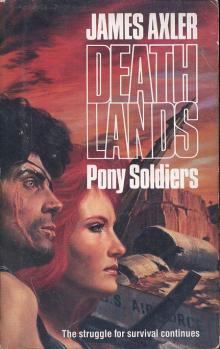 Pony Soldiers
Pony Soldiers Blood Harvest
Blood Harvest Atlantis Reprise
Atlantis Reprise Necropolis
Necropolis Haven's Blight
Haven's Blight Dragon City
Dragon City Crater Lake
Crater Lake Storm Breakers
Storm Breakers Moon Fate
Moon Fate Eden’s Twilight
Eden’s Twilight Savage Armada
Savage Armada Desolation Crossing
Desolation Crossing Time Nomads
Time Nomads Cosmic Rift
Cosmic Rift Sins of Honor
Sins of Honor Distortion Offensive
Distortion Offensive Arcadian's Asylum
Arcadian's Asylum Black Harvest
Black Harvest Iron Rage
Iron Rage Nightmare Passage
Nightmare Passage Labyrinth
Labyrinth Child of Slaughter
Child of Slaughter Cannibal Moon
Cannibal Moon Tainted Cascade
Tainted Cascade Ritual Chill
Ritual Chill Sunchild
Sunchild Wretched Earth
Wretched Earth Northstar Rising d-10
Northstar Rising d-10 Damnation Road Show
Damnation Road Show Hanging Judge
Hanging Judge Dectra Chain d-7
Dectra Chain d-7 Iceblood
Iceblood Deathlands 074: Strontium Swamp
Deathlands 074: Strontium Swamp Angel of Doom
Angel of Doom Sunspot
Sunspot Ice and Fire d-8
Ice and Fire d-8 Pilgrimage to Hell d-1
Pilgrimage to Hell d-1 Wings of Death
Wings of Death Skydark Spawn
Skydark Spawn Neutron Solstice d-3
Neutron Solstice d-3 Deathlands 067: Death Hunt
Deathlands 067: Death Hunt Pilgrimage to Hell
Pilgrimage to Hell Siren Song
Siren Song Perdition Valley
Perdition Valley Dark Fathoms
Dark Fathoms Remember Tomorrow
Remember Tomorrow Crucible of Time
Crucible of Time Savage Armada - Deathlands 53
Savage Armada - Deathlands 53 Judas Strike - Deathlands 54
Judas Strike - Deathlands 54 End Day
End Day Dark Resurrection
Dark Resurrection Deathlands - The Twilight Children
Deathlands - The Twilight Children Deathlands 068: Shaking Earth
Deathlands 068: Shaking Earth Breakthrough
Breakthrough Death Hunt
Death Hunt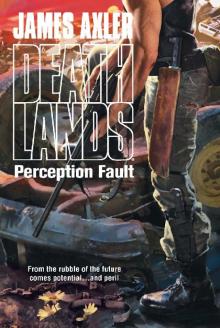 Perception Fault
Perception Fault Red Equinox
Red Equinox Motherlode
Motherlode Deathlands 071: Ritual Chill
Deathlands 071: Ritual Chill Hell Road Warriors
Hell Road Warriors Downrigger Drift
Downrigger Drift Gaia's Demise
Gaia's Demise Hell's Maw
Hell's Maw Devil's Vortex
Devil's Vortex Prodigal's Return
Prodigal's Return Deathlands 122: Forbidden Trespass
Deathlands 122: Forbidden Trespass Scarlet Dream
Scarlet Dream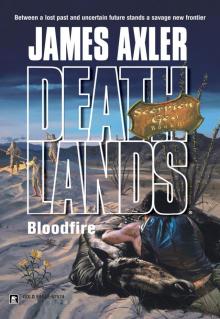 Bloodfire
Bloodfire Plague Lords (Empire of Xibalba, #1)
Plague Lords (Empire of Xibalba, #1) Moonfeast
Moonfeast Latitude Zero
Latitude Zero Lost Gates
Lost Gates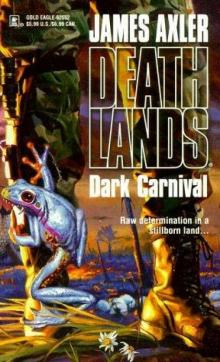 Dark Carnival
Dark Carnival Crimson Waters
Crimson Waters Vengeance Trail
Vengeance Trail Apocalypse Unborn
Apocalypse Unborn Doom Helix
Doom Helix Sorrow Space
Sorrow Space Separation
Separation Northstar Rising
Northstar Rising Red Holocaust
Red Holocaust Pandora's Redoubt
Pandora's Redoubt Chill Factor
Chill Factor Prophecy
Prophecy Crater Lake d-4
Crater Lake d-4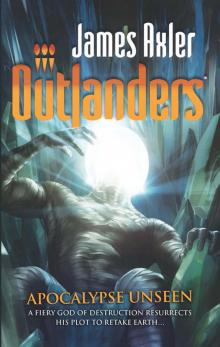 Apocalypse Unseen
Apocalypse Unseen Watersleep
Watersleep Judas Strike
Judas Strike Time Castaways
Time Castaways Baptism of Rage
Baptism of Rage Polestar Omega
Polestar Omega Red Holocaust d-2
Red Holocaust d-2 Outlanders 15 - Doom Dynasty
Outlanders 15 - Doom Dynasty Way of the Wolf
Way of the Wolf Deathlands 075: Shatter Zone
Deathlands 075: Shatter Zone Shadow Fortress
Shadow Fortress Outlander 05 - Parallax Red
Outlander 05 - Parallax Red Shaking Earth
Shaking Earth Playfair's Axiom
Playfair's Axiom Truth Engine
Truth Engine Homeward Bound
Homeward Bound Desert Kings
Desert Kings Ice and Fire
Ice and Fire Zero City
Zero City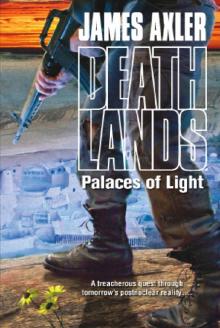 Palaces of Light
Palaces of Light No Man's Land
No Man's Land Neutron Solstice
Neutron Solstice Devil Riders
Devil Riders Thunder Road
Thunder Road Deathlands 118: Blood Red Tide
Deathlands 118: Blood Red Tide Deathlands 114: Siren Song
Deathlands 114: Siren Song Reality Echo
Reality Echo Hive Invasion
Hive Invasion God War
God War Chrono Spasm
Chrono Spasm Judgment Plague
Judgment Plague Blood Red Tide
Blood Red Tide Dectra Chain
Dectra Chain Strontium Swamp
Strontium Swamp Seedling
Seedling Shatter Zone
Shatter Zone Hellbenders
Hellbenders